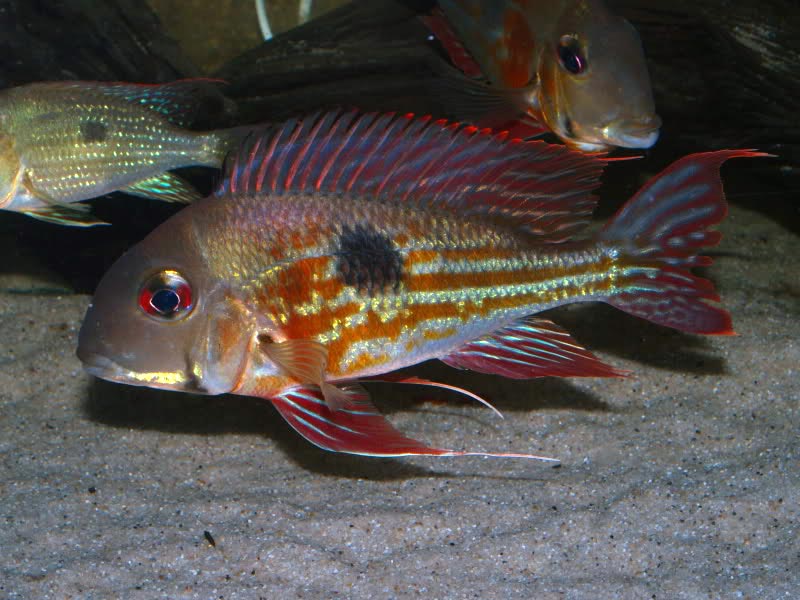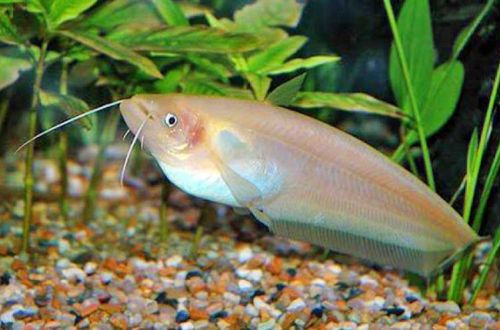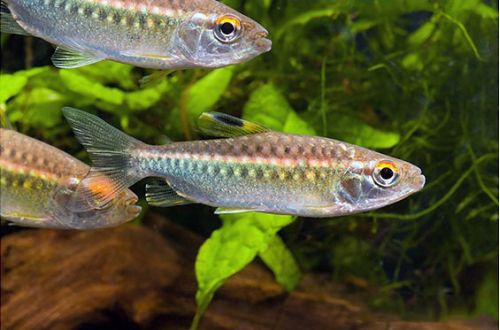
Geophagus proximus
Geophagus proximus, scientific name Geophagus proximus, belongs to the family Cichlidae (cichlids). Rarely found for sale as an independent species. Much more often it falls into the composition of a large batch of Geophagus and from there into home aquariums. It is considered an easy fish to keep and breed. It gets along well with other freshwater species, making it a good choice for the beginner aquarist.

Contents
Habitat
It comes from South America from the territory of northeastern Peru and western Brazil (Amazonas state). Found in the upper Amazon basin from the Ucayali River to the Solimões. The fish inhabits regions with a slow current, where sandy substrates are littered with numerous snags, and the water acquires a rich brown hue due to the abundance of dissolved tannins formed as a result of the decomposition of plant organic matter.
Brief information:
- The volume of the aquarium – from 600 liters.
- Temperature – 24-32°C
- Value pH — 4.0–7.0
- Water hardness – 1–10 dGH
- Substrate type – sandy
- Lighting – subdued
- Brackish water – no
- Water movement is weak
- The size of the fish is 20–22 cm.
- Food – any sinking food
- Temperament – peaceful
- Content in a group of at least 5–8 individuals
Description

Adult individuals reach a length of 20–22 cm. Males are somewhat larger than females, are brighter in color and have elongated last rays of fins. In addition, it is not uncommon for dominant alpha males to develop a nuchal hump. The coloration is bluish, but it is sometimes almost invisible due to the yellow-orange pigmentation. There is a characteristic dark large spot on the body. The fins and tail are red with blue strokes, dots.
Food
They feed at the bottom, sifting the soil with their mouths in search of food – small invertebrates, as well as particles of detritus, algae and other organic matter. In the home aquarium, it will accept most popular sinking foods containing herbal supplements. For example, dry flakes, granules combined with frozen brine shrimp, daphnia, bloodworm pieces. Feed 3-4 times a day in small portions.
Maintenance and care, arrangement of the aquarium
The optimal size of the aquarium for a group of 5-8 fish starts from 600 liters. The design is arbitrary, the only thing you need to pay attention to is the substrate. It is recommended to use sandy soil without coarse materials such as gravel or small pebbles. Large pebbles can get stuck in the mouth, damage the gills.
Geophagus proximus needs slightly acidic water with low carbonate hardness. It is desirable that the water contains some dissolved tannins, which are invariably present in the natural habitat of this species of cichlids. One of the popular ways is to add the dried leaves of some trees to the aquarium, which release the necessary substances during the decomposition process. However, in the case of Geophagus, this can lead to excessive clogging of the soil, so the use of special essences will be optimal. Just a few drops can give the desired effect.
Long-term successful keeping also depends on maintaining stable water conditions. Sharp temperature fluctuations, jumps in pH and dGH values should not be allowed, and concentrations of nitrogen cycle products (ammonia, nitrites, nitrates) must be monitored. The key to this is the installation of a productive filtration system and regular maintenance of the aquarium.
Behavior and Compatibility
Quite a peaceful fish, perfectly compatible with many freshwater species. Avoid aggressive and territorial neighbors, as well as tiny fish. The latter can become an accidental “snack” if they are too careless.
Intraspecific relationships of Geophagus proximus are built on a hierarchy, where alpha males are at the top. Despite such a social structure, weak individuals are not attacked by stronger relatives. It is recommended to maintain in a group of 5-8 individuals.
Breeding / breeding
Fish do not impose special requirements for their breeding. Regular maintenance of the aquarium and a quality diet is enough. With the onset of the spawning season, the male and female form a temporary pair, which, however, sometimes persists for several years. Fish choose a place of future spawning at the bottom, the center of which is usually some flat surface, for example, a flat stone. The female lays up to 200 eggs, which, after fertilization, she takes into her mouth, where they will be for the entire incubation period. The male may also be involved in this process. When the fry are born, they continue to be in their safe hiding place – in the mouth of their parents, who periodically release them into free swimming for a short time. Each time the gaps are increasing. Parents continue to protect their offspring until they are large enough, then adult fish lose interest in them.
Fish diseases
The main cause of diseases lies in the conditions of detention, if they go beyond the permissible range, then immunity suppression inevitably occurs and the fish becomes susceptible to various infections that are inevitably present in the environment. If the first suspicions arise that the fish is sick, the first step is to check the water parameters and the presence of dangerous concentrations of nitrogen cycle products. Restoration of normal/suitable conditions often promotes healing. However, in some cases, medical treatment is indispensable. Read more about symptoms and treatments in the Aquarium Fish Diseases section.





